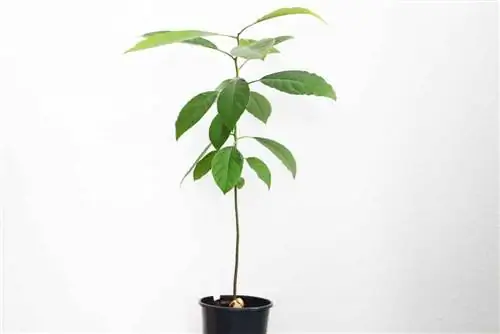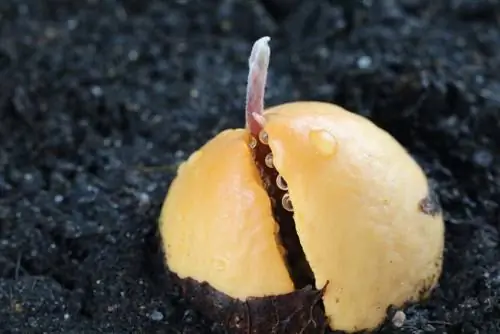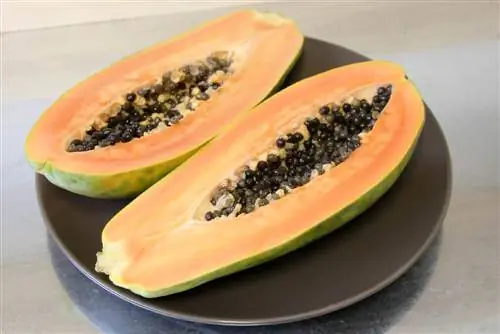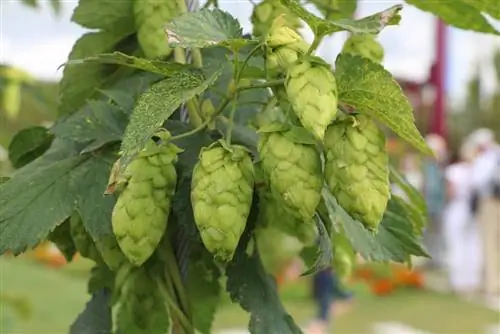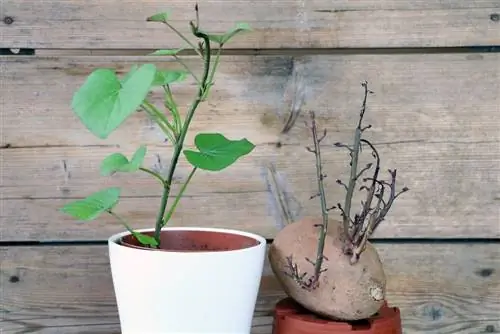- Author admin [email protected].
- Public 2023-12-17 03:39.
- Last modified 2025-01-24 12:45.
An exotic green plant grows leaf by leaf from an inconspicuous core. It goes by the name 'Avocado'. No fruit will ripen on it. Nor will it become a stately tree, as is usual in its homeland. But she will always be a graceful appearance. Do you also have a core left over? This is how you help the avocado to emerge from its brown shell.
Origin and appearance
Far from the tropics it finds its way to us: the shriveled green avocado fruit. In their native South America, the evergreen avocado trees with simple, elongated leaves grow up to 20 meters high. Yellow-green flowers that have an intense scent develop at the tips of their branches. Wild varieties grow everywhere there, but the avocado fruits available here only come from the 'Persea americana' variety. We rarely buy the avocado plant, which is why we like to pull it from the brown seeds. In the room, the avocado remains relatively small at around 2 m. Unfortunately, avocado plants grown from seeds almost never bear fruit, so even the best care doesn't help.
Bloom
Avocado trees grown in our latitudes bloom less frequently than their counterparts in the tropics, but it is not impossible. If you take good care of your tree and give it a sheltered and sunny spot outdoors in summer, it could reward you with yellow-green flowers. However, it does not bloom until it is 2-4 years old at the earliest. If the male and female flowers bloom at the same time, you can try pollinating with a brush. With a bit of luck it could work. Otherwise, fruits are extremely rare in this country. Regular pruning and occasional flower fertilizer stimulate flower formation.
Core
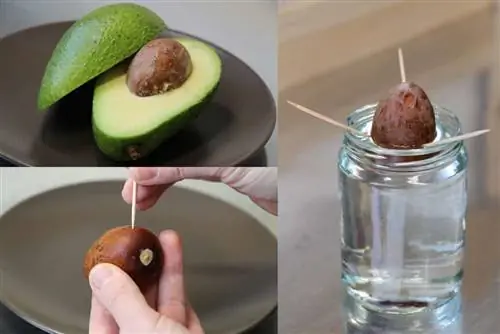
To start growing avocados, you first need a pit. You don't have to buy it expensively in a garden center or online, a trip to the supermarket is enough. Every Essavocado you can buy there has a single seed about the size of a table tennis ball hidden inside. When buying, make sure that the avocado is undamaged and ripe. Shake the avocado back and forth. Do you hear a light knock? If so, then the core is no longer firmly attached to the pulp. This makes later core removal much easier. This is how you free the core from its green home.
- Cut the green pulp in half. It doesn't matter whether you cut lengthwise or crosswise. Just be careful not to damage the core.
- Hold each avocado half with one hand.
- Now rotate the avocado halves in opposite directions.
- The two halves separate and the brown core becomes visible. Take out the core.
- Wash the core and then dry it with some kitchen paper.
- The brown shell is susceptible to mold. Remove it now if it comes off easily. If necessary, this can also be done at a later date.
The kernel is now ready for germination.
Tip:
You can recognize a ripe fruit by its dark green, almost brownish peel. The flesh is soft and gives easily when pressed with your finger. Cuts on the surface do not hinder germination, but can later become moldy.
Germination time
The ideal time of year for your own experiments with the brown avocado pit is late winter. Then there is the best chance of success. Because the avocado seed takes a long time to germinate. It can take several weeks or even a few months until some roots and leaves have formed from the core. Then spring is already here and its sun rays give the little plant an extra portion of light and warmth. With this good timing, the avocado can continue to develop optimally.
Germination in water
One of the methods often recommended for avocado germination is direct germination in water. You need:
- an avocado pit
- a glass
- Water
- three toothpicks
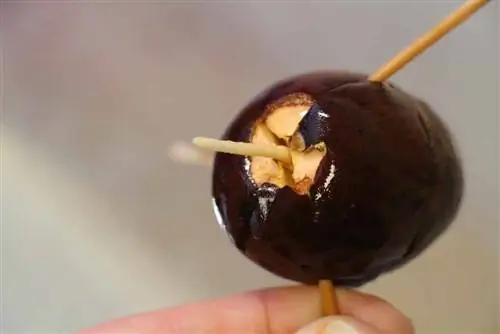
The avocado pit is placed in a glass filled with water. However, only half of it can be in the water; the other half of the core must remain in the air. To achieve this, you need the three toothpicks.
- Insert the toothpicks at equal intervals around the center of the core about 5 mm.
- Place the core in the water glass with the tip facing up. The toothpicks rest on the edge of the glass and prevent the core from diving deeper into the water.
- Place the glass in a warm place, 25 degrees is ideal.
- Refill evaporated water again and again.
- The glass must be placed in a bright location when the shoot is visible at the latest.
- After germination, the avocado seedling grows quickly.
- Transplant it once it has developed enough roots and some leaves.
- Only pot the roots! The avocado pit remains visible on the surface of the earth.
Tip:
If mold appears during germination, wipe it off carefully with crepe paper.
Germination in the soil
You can also plant the avocado pit directly in the ground. So you miss out on the rootsy half of the drama, but it works. A mini greenhouse is ideal, but not a must. This is how you proceed with core planting:
- Fill a small pot with potting soil.
- Place the core halfway into the soil. The other half must visibly stick out of the ground.
- Water the soil a little.
- Always keep the soil moist but not too wet.
- Spray the core regularly with water to prevent it from drying out.
- Transplant the avocado seedling in spring.
Tip:
With this method, the pointed side of the core must also face upwards. The blunt side is buried. This is the only way germination occurs.
Location
This tropical plant has an insatiable hunger for light. A bright, sunny window sill is well suited. A winter garden with a large glass area that lets in a lot of light is even better. If the avocado is too dark, it tends to grow so-called horny and simply shoots up. In summer the avocado tree, or in this country “the avocado bush”, is welcome to go out into the garden. After all, it is not a typical houseplant and would grow continuously in the fresh air in its homeland. The outdoor location must meet a few requirements.
- sheltered from the wind
- sunny
- without night frosts
- Very young plants should not go outdoors yet.
Staying outdoors should depend on the temperatures and less on the calendar. In addition to light, warmth is the second basic need of the avocado during the growing season. It won't be completely tropical here, but it should be 22-25 degrees if possible. It can also be damp, whenever that can be achieved.
In winter in this country, the avocado needs, if possible, a cooler location for the upcoming rest period, which is taken due to a lack of light.
Planting soil
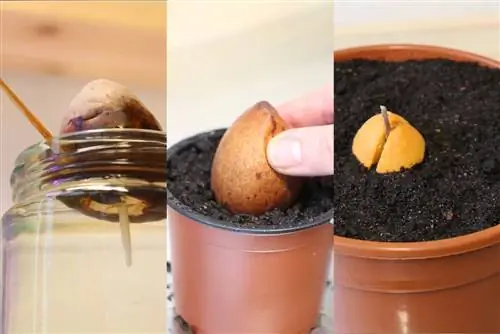
Your avocado plant is quite modest and flexible when it comes to the composition of the substrate. We have had good experiences with the following mixtures:
- normal potting soil
- Planting soil and some clay content
- 1:1 mixture of sand and potting soil
- Special soil for palm trees and citrus plants
Always use a suitable substrate, both when first planting and later when transplanting. The soil should be loose and well-drained, with not too much s alt. Older avocado plants prefer loamy soil, young plants prefer the soil for palm trees.
Pouring
In summer the Persea needs a lot of water. Keep the soil moist without causing waterlogging. Spray the plant daily, preferably several times, with lukewarm water. High humidity is important, otherwise the small avocado tree will become ill or pests will spread. In winter, watering must be significantly reduced. Only a little water is then required so that the avocado does not drop its leaves. In winter you can let the root ball dry out and then water it again.
Fertilize
Very young avocado plants do not need fertilizer. You get all the nutrients you need directly from the kernel. Only after about 6 months can you slowly get the young plant used to fertilizer. To do this, add some liquid fertilizer to the water about every 14 days. Only use a quarter of the usual amount of fertilizer. Older plants need more fertilizer, but less frequently. A rhythm of four to six weeks from March to the beginning of September is sufficient. The following fertilizers are possible:
- Fertilizer for citrus plants
- Fertilizer for green plants
- Universal fertilizer
- Container Plant Fertilizer
If you want the avocado to continue to thrive in the winter, you can continue fertilizing. However, if you want to take a winter break or spend the winter in cooler temperatures, stop fertilizing completely. Also repot the avocado annually in spring. In doing so, replace the soil completely.
Cutting
Strictly speaking, an avocado tree does not need to be pruned. So that it remains suitable for indoor use in terms of its size and develops a beautiful, branched growth, it should still be cut regularly.
- optimal time: end of winter period
- combine with repotting
- Cut tips with clean and sharp secateurs
- Cutting circumference can be determined individually
- then spray the avocado plant with lukewarm water
Tip:
Do not cut a young plant too early. Only at the age of three months or later can you encourage new branches by trimming the tip.
Repotting

The avocado bush needs to be repotted annually. On the one hand, pots that are too narrow can cause root rot in avocados, and on the other hand, the plant likes fresh soil on a regular basis.
- Time: every spring
- completely replace old earth
- Use loose and well-drained soil
- the new pot should be bigger
Tip:
Simply mix your avocado soil yourself. Mix normal potting soil with sand in a ratio of 1:1.
Diseases and pests
Diseases and pests usually stay away with good care. If the leaf tips become dry, it could be a sign of lack of water or little fertilizer. A location near the window that is too sunny can also cause sunburn. A location that is too warm or dark in winter is associated with leaf loss. Brown leaves don't always have to be the end of an avocado.
Scale insects and spider mites occasionally appear. Dry heating air is usually the cause. Take appropriate measures and also check current care. If care errors are made and not corrected, the infestation can reoccur and permanently weaken the avocado. Spray the plant occasionally to prevent this.
Wintering
It would be ideal if the avocado plant could enjoy the same amount of light, warmth and humidity all year round. If you have a bright room or a winter garden, you can keep the avocado tree warm over the winter. Otherwise, the avocado in our latitudes has to take a short break in growth in winter. During this time it needs a temperature reduction. The cool place should be at 10 to 15 degrees room temperature. However, it should still provide plenty of light and, if possible, high humidity.
If you don't have suitable winter quarters, that's not a big deal. The avocado tree can also remain in a heated room throughout. However, if there is not enough light for it, it may drop some leaves. In spring it sprouts again. In winter the avocado tree needs less water and less fertilizer. The watering also depends on how warm it is in the winter location. Therefore, water as needed. In winter, the soil can dry out between two waterings.

